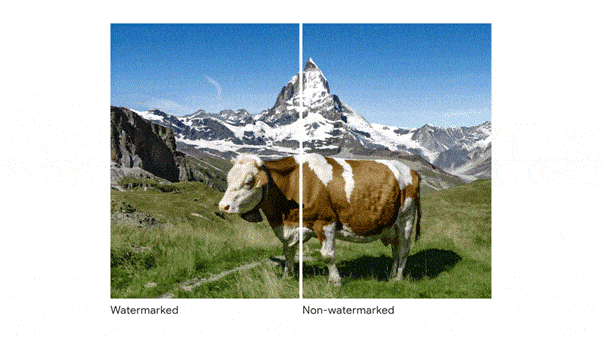Note: This is a guest post written by Jeeva Shanmugam. You can reach him on Instagram, X, or email – In recent years, Artificial Intelligence (AI) has made some truly astonishing strides, particularly in the area of computer-generated imagery. These AI-generated images have become incredibly lifelike, making it often difficult to tell them apart from actual originally taken images.
While exhilarating, this tremendous accomplishment has given rise to a number of worries. The potential use of AI-generated images for deceptive reasons, such as the dissemination of false information, propaganda, or even the impersonation of real people, is a major cause for concern. Therefore, it is critical to develop tools for identifying AI-generated images.

Google has unveiled SynthID as a creative tool to overcome this problem. SynthID is a system that embeds a digital watermark right into an AI-generated image’s pixels. It’s important to note that although this watermark cannot be seen by the naked eye, it may be recognized by specialized software. Let’s have a closer closer look at the SynthID.
Key Highlights:
- SynthID, developed by Google, is a powerful tool with over 99% accuracy in identifying AI-generated images, addressing concerns of deceptive image use.
- Its robustness allows SynthID to detect watermarked AI-generated images even after heavvy editing, making it a valuable asset for major tech companies like Facebook and Twitter.
- The future of SynthID remains promising as it adapts to evolving AI-generated image technology, ensuring its continued effectiveness in identifying AI-created content.
How SynthID Works
Two machine learning models are used by SynthID to carry out its operations. The watermarking model, the first one, is in charge of adding a watermark to an image. This watermark within an image is identified using the second model, also known as the identification model.
The watermarking model works by creating a random bit sequence at the beginning. Then, a watermark pattern is made using this bit pattern. By slightly altering the pixel values, this watermark pattern is then softly incorporated into the image.

The identification model, on the other hand, gets started by extracting the watermark pattern from a picture. This watermark pattern is extracted and then compared to a database of known watermark patterns.
The extracted watermark pattern is compared to a known watermark pattern, and if a match is made, it is determined that artificial intelligence was used to create the image.
Advantages of SynthID
When it comes to identifying AI-generated images, SynthID offers a number of noteworthy benefits. First of all, it displays a remarkable degree of precision. With an accuracy record of more than 99%, SynthID has repeatedly shown an exceptional capacity to accurately recognize AI-generated images in numerous tests.

Second, SynthID demonstrates remarkable durability. Even when the images have undergone numerous alterations, it can consistently detect watermarks within those images. For example, SynthID can still recognize watermarked material even after an image has been cropped, scaled, or compressed.
Thirdly, SynthID’s efficiency is a major asset. It is a very effective and useful solution because it excels at quickly identifying AI-generated images , completing this work in a couple of milliseconds.
Limitations of SynthID
Although SynthID is a useful tool, there are a few drawbacks to be aware of.
In order to identify images, SynthID first looks for watermarks in the images. Consequently, SynthID won’t be able to identify an AI-generated image if it doesn’t have a watermark.
Additionally, SynthID may experience difficulties correctly detecting highly complex AI-generated images that are carefully created to avoid watermarks.
Here are some real-world instances and data demonstrating SynthID’s capabilities:
- Recent testing with AI-generated images showed SynthID to have an amazing accuracy rate of over 99%.
- The discovery of AI-generated images used in misleading tactics like fake news and propaganda has been made possible in large part by SynthID.
- Google, Facebook, and X (formely Twitter) are just a few of the well-known companies that have adopted SynthID to improve their capacity to identify AI-generated images
Future of SynthID
Looking ahead, SynthID’s future looks bright. SynthID will be updated to stay current as AI-generated images develop and grow more complex.
However, the robustness of SynthID’s underlying technology ensures that it will continue to be useful for years to come in detecting AI-generated images.
Wrapping It All
In conclusion, tools like SynthID have become more important safeguards against the abuse of AI-generated images for misleading purposes as artificial intelligence continues to push the frontiers of computer-generated imagery.
The novel watermarking method used by SynthID, along with its amazing precision, resistance to image manipulation, and effective detection skills, make it an invaluable tool in the war against propaganda and false information.
Even if it has obvious limits, the fact that it has worked with well-known companies like Google, Facebook, and Twitter highlights its significance in the continuing conflict over AI-generated content.
With a dedication to continuous improvement and a solid technological foundation, SynthID seems ready to take on a significant role in this area for many years to come, providing a reassuring answer in a time of realistic AI-generated images..
I hope this articlegave you some insightful new information. Please feel free to ask any questions if you have any.
Source: Google DeepMind




